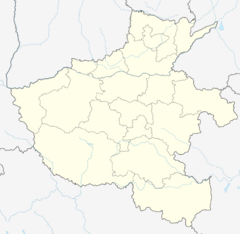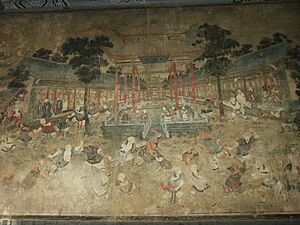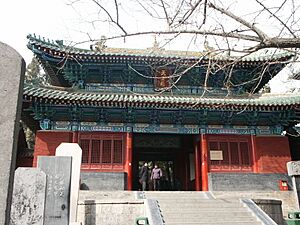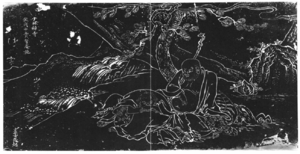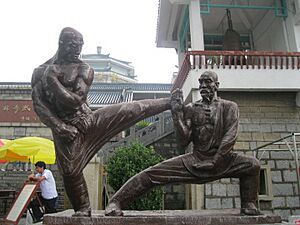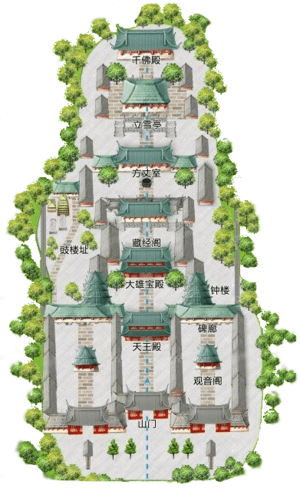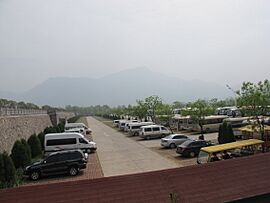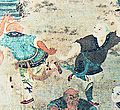Shaolin Monastery facts for kids
Quick facts for kids Shaolin Monastery |
|
|---|---|
|
少林寺
|
|

Mahavira Hall, the monastery's main building, in 2007
|
|
| Religion | |
| Affiliation | Chan Buddhism |
| Status | Active |
| Location | |
| Location | Dengfeng, Zhengzhou, Henan, China |
| Architecture | |
| Architectural style | Chinese architecture |
| Date established | 495 |
| UNESCO World Heritage Site | |
| Location | China |
| Part of | Historic Monuments of Dengfeng in "The Centre of Heaven and Earth" |
| Criteria | Cultural: (iv) |
| Inscription | 2010 (34th Session) |
| Shaolin Monastery | |||||||||||||||||||||||||||
|---|---|---|---|---|---|---|---|---|---|---|---|---|---|---|---|---|---|---|---|---|---|---|---|---|---|---|---|

"Shaolin Temple" in Chinese
|
|||||||||||||||||||||||||||
| Chinese | 少林寺 | ||||||||||||||||||||||||||
| Literal meaning | "Temple of Shao[shi Mountain] Woods" | ||||||||||||||||||||||||||
|
|||||||||||||||||||||||||||
The Shaolin Monastery (少林寺; shàolínsì), also known as Shaolin Temple, is a famous Buddhist temple in China. Many people believe it is the birthplace of Chan Buddhism (which is like Zen Buddhism) and the home of Shaolin kung fu.
It is located at the foot of Wuru Peak, part of the Songshan mountain range, in Dengfeng county, Henan province, China. The name "Shaolin" means "forest of Mount Shaoshi," referring to its location in an ancient grove on Mount Shaoshi. Mount Song has been an important sacred mountain in China for a very long time.
The first abbot (leader) of Shaolin, Butuo Buddhabhadra, worked on translating Buddhist texts. Later, a legendary monk named Bodhidharma arrived in 527. He spent nine years meditating in a cave nearby. He is seen as the first leader of Chan Buddhism in China.
The temple's old buildings are very beautiful and important. They are listed as a UNESCO World Heritage Site. Besides its role in Buddhism, Shaolin Temple is famous for its amazing Kung Fu martial arts. Shaolin monks have spent centuries developing and improving these skills.
Shaolin culture has four main parts: Chan Buddhism, martial arts, Buddhist art, and traditional Chinese medicine. This rich culture is still a big part of daily life at the temple. Many people visit Shaolin for spiritual reasons and to learn about its culture. Shaolin culture has also spread worldwide through official centers and foreign students.
Contents
History of Shaolin Temple
Early Beginnings
The Shaolin Monastery was built in 495 AD. A monk named Batuo (also known as Buddhabhadra) helped establish it. He was supported by the Emperor Xiaowen of Northern Wei. Shaolin became a key place for studying and translating Buddhist scriptures. It also attracted many respected Buddhist teachers.
Historical records show that martial arts were practiced at the temple even in these early days. Batuo's students, Sengchou and Huiguang, continued his teachings. Other Indian monks, Lenamoti and Putiliuzhi, came to Shaolin in 506 to translate more scriptures.
Bodhidharma and Chan Buddhism
In 527, Bodhidharma arrived at Shaolin Temple. He was an Indian monk who traveled to China to share Chan Buddhism. He taught that meditation and understanding your own mind were very important. Bodhidharma's teachings helped Shaolin Temple become the main center for Chinese Chan Buddhism.
A famous story says that Bodhidharma's student, Huike, cut off his arm to show how dedicated he was to learning from his master. Huike later had to leave the temple because Buddhism was being persecuted. However, the temple was restored in 580 and renamed for a short time.
It's a popular belief that Bodhidharma created martial arts at Shaolin. However, historians say this idea became popular much later, in the 20th century, through novels and books. Older writings mention Bodhidharma and martial arts separately, but don't connect them. Still, Bodhidharma is a very important figure in Shaolin's history and legends.
Growth and Challenges
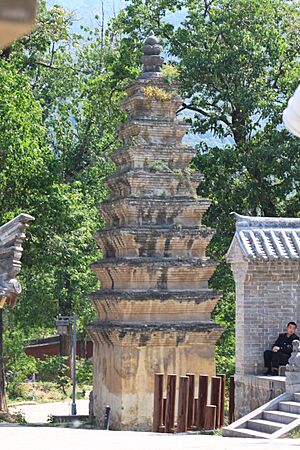

During the Sui dynasty, Emperor Wen, who was a Buddhist, gave the temple its original name back and granted it a lot of land. Shaolin grew into a large and wealthy temple. It became a major center for Chan Buddhism, with monks from all over China visiting.
Towards the end of the Sui dynasty, the temple's wealth attracted thieves. The monks had to organize themselves to protect the temple. In the early Tang dynasty, thirteen Shaolin monks famously helped Li Shimin, who later became the second Tang emperor. They helped him defeat a rival warlord. Because of their help, Emperor Taizong sent a letter of thanks and gave the temple more land.
During the Tang and Song dynasties, Shaolin Temple was very successful. It owned vast amounts of land and had thousands of monks. The Chan Buddhist school became the largest Buddhist school in China during the Tang dynasty.
Later Dynasties and Rebuilding
In the Yuan dynasty, Emperor Shizu appointed the monk Xueting Fuyu as the abbot of Shaolin. He oversaw many new buildings, like the Bell Tower and Drum Tower. He also started a system for naming future generations of Shaolin students.
The end of the Yuan dynasty brought trouble. In the 14th century, rebels attacked the monastery, destroying much of it. The monks had to leave for a while.
However, Shaolin recovered during the Ming dynasty. Monks who had fled returned. Shaolin monks were even recruited by the Ming government to help fight against Japanese pirates. Because of their bravery, the government rebuilt parts of the temple. Shaolin kung fu became very respected across China. The temple reached its peak during the mid-16th century.
In 1641, rebel forces attacked the monastery again, damaging it and scattering the monks. The temple was mostly in ruins until the early 18th century, when the Qing dynasty government helped restore it. Qing emperors, like Kangxi and Qianlong, visited the temple, wrote poems, and funded important repairs.
There's a popular story that the Qing government destroyed Shaolin Temple because of anti-Qing activities. While this story is famous in martial arts legends, scholars believe it's mostly fiction.
Modern Times
In the early 20th century, during the Republic of China period, Shaolin Temple faced more wars. In 1912, a monk named Yunsong Henglin organized a militia to protect the local area from bandits.
In 1928, during conflicts between warlords, parts of the temple were burned down by Shi Yousan's troops. Many ancient buildings and valuable Buddhist scriptures were destroyed.
After the People's Republic of China was founded in 1949, the government became officially atheist. During the Cultural Revolution, Shaolin monks were forced to leave, and Buddha statues were destroyed.
After this difficult period, Shaolin Temple was repaired and rebuilt. Many destroyed buildings, like the Mahavira Hall, were reconstructed. Other ancient parts, like the Pagoda Forest, remained. In 2010, Shaolin's historical buildings were officially added to the UNESCO World Heritage List. This helps protect the site and provides funding for its upkeep.
Since the 1990s, the temple has worked to spread Shaolin culture globally. It has opened cultural centers in many countries to teach Chan Buddhism and Shaolin kung fu. In 2018, the national flag of China was raised at the monastery for the first time, as part of a national "patriotism drive."
How Shaolin Temple is Managed
The monastery was traditionally led by an abbot. However, today, a committee mostly made up of government officials helps lead the monastery. The government also appoints the treasurer, so the abbot has less control over the temple's money. The monastery shares its earnings with the local government.
Achievements and Recognition
Shaolin Temple has received many honors:
- In 2004, California in the US declared March 21 as California Songshan Shaolin Temple Day.
- In 2007, it was named a National 5A-level Scenic Spot in China.
- On August 1, 2010, several of its buildings, including the Pagoda Forest, became UNESCO World Cultural Heritage sites.
- In 2013, the temple's Sutra Pavilion was recognized for its ancient books.
- Also in 2013, the Chinese government listed Shaolin Temple's ancient buildings as important cultural relics.
Shaolin Culture
Rich Heritage
Shaolin Temple has a unique culture that combines several important parts: Chan Buddhism, martial arts, traditional medicine, and art. These parts work together and are all connected to the temple's history and traditions. Chan Buddhism is at the heart of it, with martial arts, medicine, and art being ways this spiritual practice is shown.
Shaolin culture has also taken in ideas from Confucianism and Taoism, two other important Chinese philosophies. The temple offers programs for people to experience Shaolin culture, including Chan meditation, kung fu, medicine, and calligraphy. Chan practice helps people find peace and patience, leading to a more positive and meaningful life. You can practice Chan in many ways, from daily activities like eating and walking to special practices like meditation and martial arts.
Shaolin kung fu involves different skills based on attack and defense movements. These movements are put together into "forms." The way these movements are structured is based on ancient Chinese medical knowledge and how the body moves naturally. Shaolin kung fu teaches balance between dynamic and static movements, and between hard and soft techniques.
The Shaolin community works hard to protect and develop its heritage. They aim to help people achieve their full potential through natural body movements, following the idea of harmony between humans and nature.
Sharing Shaolin Culture Globally
Shaolin Temple is important both in China and around the world. Since the 1970s, the temple has increased its cultural exchanges with other countries. Many people from different backgrounds have visited, including dancers, martial artists, and even famous political leaders like Russian president Vladimir Putin and former US secretary of state Henry Kissinger.
Today, there are over forty official Shaolin cultural centers in many countries. Shaolin monks teach Buddhist lessons, martial arts, and meditation at these centers. Shaolin Cultural Festivals are also held around the world to share the spiritual and cultural values of Shaolin.
Myths and Stories
In Western culture, Asian monks are often shown as wise, peaceful, and spiritual people. This idea started in the 19th century when Western explorers first met Buddhist monks. While this is a simple way to see a diverse group of people, the image has stuck.
Buildings of Shaolin Temple
Protecting the Site
The original Shaolin Temple was badly damaged in 1928. Later, during the Cultural Revolution, it suffered more harm. However, in 1982, a law was passed to protect cultural heritage in China.
The government started rebuilding the monastery as a tourist site. They rebuilt and restored many halls. Since old records were destroyed, architects talked to elders who remembered the temple before 1928 to get details.
By 2010, a new management group was formed to balance keeping the temple historically accurate with making it suitable for tourists. UNESCO also became involved. In 2010, several ancient sites around Dengfeng, including parts of Shaolin Temple, became a single UNESCO World Heritage Site. This includes the main temple area, its cemetery (the Pagoda Forest), and the Chuzu Temple.
Getting to the Temple
The Shaolin Temple is located in the middle of Mount Song. It's about 50 kilometers (31 miles) from Luoyang and 73 kilometers (45 miles) from Zhengzhou. You can usually get there by bus or car from either city.
The main entrance for visitors is the North Gate, which was built to make it easier for people to arrive.
Layout of the Temple
The temple grounds are about 160 meters (525 feet) wide and 360 meters (1,180 feet) long. The buildings are arranged in three long sections. There are seven main halls along the central path and other halls around them. These halls often act as museums, displaying Buddhist artifacts. You can also see many memorials, monuments, and ancient ginkgo trees.
Here are some of the important buildings and areas:
Main Temple Area
- Shanmen (Mountain Gate): Built in 1735, this is the main entrance. The sign above the gate says "Shaolin Temple."
- Forest of Steles: This area has many stone tablets with writings and carvings.
- Ciyun-tang (Hall of Compassionate Clouds): Built in 1686, it has a corridor with 124 stone tablets from different time periods.
- Tianwang Dian (Hall of the Four Heavenly Kings): Built during the Yuan dynasty, it has statues of guardian figures and the Four Heavenly Kings.
- Bell Tower: Built in 1345, it holds a large bell from 1204. A famous stone tablet here, from 728 AD, tells the story of Shaolin monks helping Emperor Taizong.
- Drum Tower: Built in 1300, it stands opposite the Bell Tower.
- Mahavira Hall (Main Hall): Rebuilt in 1985, this is the most important hall. It has statues of three Buddhas and other important figures.
- Dining Hall: Rebuilt in 1995, this is where the monks eat.
- Sutra Room: Where Buddhist scriptures are kept.
- Chan-tang (Hall of Dhyana): A hall for meditation.
- Fazhang-shi (Abbot's Room): This was once used by Emperor Qianlong during his visit in 1750. It contains art and the lineage chart of Shaolin.
- Lixue-ting (Pavilion of He Who Stands in Snow): Also known as Damo-ting, this pavilion is linked to the story of Bodhidharma and his student Huike.
- Baiyi-dian (Hall of the White Robe): Built during the Qing dynasty, it has murals showing kung fu forms.
- Qianfo-dian (Hall of a Thousand Buddhas): Built in 1588, it has famous murals, including one about thirteen staff-wielding monks saving the Tang king.
- Shaolin Pharmacy Bureau: Rebuilt in 2004, this building was originally for traditional medicine.
- Shaolin Temple Wushu Guan (Martial Arts Hall): A place dedicated to martial arts.
Chuzu Temple
This temple is also part of the Shaolin complex and has historical significance.
Pagoda Forest
- Forest of Pagodas Yard: Located about 300 meters (984 feet) west of the main monastery, this is a cemetery for important monks. It has 240 tomb pagodas (small towers) from different dynasties, dating back to 791 AD.
Images for kids
See also
 In Spanish: Shaolin para niños
In Spanish: Shaolin para niños
- Shaolin Temple UK
- Bayon- Buddhist temple depicting martial arts bas-relief
- Angkor Wat- Buddhist–Hindu temple depicting martial arts bas-relief


